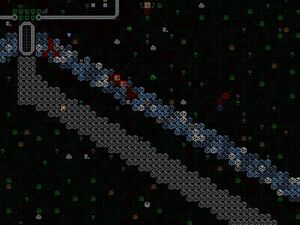- v50 information can now be added to pages in the main namespace. v0.47 information can still be found in the DF2014 namespace. See here for more details on the new versioning policy.
- Use this page to report any issues related to the migration.
Difference between revisions of "v0.31:Road"
(Added a section on how to pave elegantly at an angle) |
m (fixed picture location) |
||
| Line 9: | Line 9: | ||
== Paving at an Angle == | == Paving at an Angle == | ||
| − | It is possible and fairly simple to pave at nearly any angle. In the picture to the right, the road begins 4 squares below the river, and ends 5 squares below the river. Notice also that the road is not exactly stepped with the river, which helps to reduce the blocky look. To get angles that are not horizontal/vertical, the trick is to find the stepping pattern that will get you there. | + | [[Image:roadangle.jpg|thumb|right|Sleight Angles]]It is possible and fairly simple to pave at nearly any angle. In the picture to the right, the road begins 4 squares below the river, and ends 5 squares below the river. Notice also that the road is not exactly stepped with the river, which helps to reduce the blocky look. To get angles that are not horizontal/vertical, the trick is to find the stepping pattern that will get you there. |
Let's say we want the road to travel 50 east and 30 down. The ratio is 50/30 = 5/3. For every 5 squares over, go 3 squares down. To make a stepping pattern, spread the smaller number evenly across the bigger number. In the example | Let's say we want the road to travel 50 east and 30 down. The ratio is 50/30 = 5/3. For every 5 squares over, go 3 squares down. To make a stepping pattern, spread the smaller number evenly across the bigger number. In the example | ||
| Line 18: | Line 18: | ||
* 1 down, 1 over | * 1 down, 1 over | ||
Repeating the pattern results in a pair of [1down,1over] instructions next to each other every five steps, which is part of the pattern that gets a road to go 50 over and 30 down. | Repeating the pattern results in a pair of [1down,1over] instructions next to each other every five steps, which is part of the pattern that gets a road to go 50 over and 30 down. | ||
| − | + | ||
{{buildings}} | {{buildings}} | ||
Revision as of 01:58, 8 May 2010
| This article is about an older version of DF. |
Roads are a construction which paves over large sections of flat terrain. They are most commonly used to give Template:L a reliable path to your fortress from the map's edge. A dwarf with the Template:L labor must haul materials (if any) to the site and design the structure before it can be finished by any available dwarf.
Dirt roads (b - O) can be constructed for free on any soil, removing shrubs and trees and preventing new ones from growing. However, they wear away over time, and have to be reconstructed periodically. Depending on the size of the road, this can be a hassle.
Paved roads (b - o) can be constructed with any building material, including Template:L, Template:Ls, Template:L and metal Template:L. These roads are permanent, and use less material than paving the same space with constructed Template:Ls. To avoid the hassle of long-distance hauling, it is advisable to place a Template:L near the desired site for your Architect to get materials from.
Paving at an Angle
It is possible and fairly simple to pave at nearly any angle. In the picture to the right, the road begins 4 squares below the river, and ends 5 squares below the river. Notice also that the road is not exactly stepped with the river, which helps to reduce the blocky look. To get angles that are not horizontal/vertical, the trick is to find the stepping pattern that will get you there.
Let's say we want the road to travel 50 east and 30 down. The ratio is 50/30 = 5/3. For every 5 squares over, go 3 squares down. To make a stepping pattern, spread the smaller number evenly across the bigger number. In the example
- 1 down, 1 over
- 1 over
- 1 down, 1 over
- 1 over
- 1 down, 1 over
Repeating the pattern results in a pair of [1down,1over] instructions next to each other every five steps, which is part of the pattern that gets a road to go 50 over and 30 down.
| Rooms |
Barracks • Bedroom • Dining room • Dormitory • Jail • Meeting hall • Hospital • Office • Sculpture garden • Tomb • Zoo |
|---|---|
| Furniture |
Animal trap • Anvil • Armor stand • Bed • Bin • Box • Bucket • Cabinet • Cage • Coffin • Restraint • Seat • Statue • Table • Weapon rack |
| Access | |
| Constructions | |
| Machine & Trap parts |
Axle • Gear assembly • Millstone • Screw pump • Water wheel • Windmill • Lever • Pressure plate • Trap • Support |
| Other Buildings | |
| Related Articles | |
